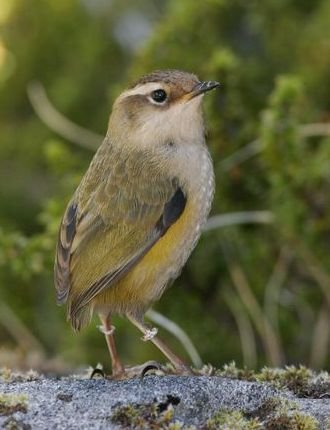Acanthisittidae – New Zealand Wrens

The New Zealand wrens Acanthisittidae are a family of tiny passerines endemic to New Zealand. They were represented by six known species in four or five genera, although only two species survive in two genera today. They are understood to form a distinct lineage within the passerines. More recent studies suggest that they form a third (neither oscines or suboscines), most ancient, suborder Acanthisitti and have no living close relatives at all. They are called ‘wrens’ due to similarities in appearance and behaviour to the true wrens Troglodytidae.
New Zealand wrens are mostly insectivorous foragers of New Zealand’s forests, with one species, the New Zealand rockwren, being restricted to alpine areas. Both the remaining species are poor fliers and four of the five extinct species are known to (or are suspected of having) been flightless (based on observations of living birds and the size of their sterna); along with the long-legged bunting from the Canary Islands, they are the only passerines known to have lost the ability to fly. Of the species for which the plumage is known they are drab-coloured birds with brown-green plumage. They form monogamous pair bonds to raise their young laying their eggs in small nests in trees or amongst rocks. They are diurnal and like all New Zealand passerines, for the most part, are sedentary.
They, like many New Zealand birds, suffered several extinctions after the arrival of humans in New Zealand. Two species became extinct after the arrival of the Māori and the Polynesian rat, and are known today only from fossil remains; a third, the Stephens Island wren, became extinct on the main islands, surviving only as a relict population on Stephens Island in the Cook Strait. This species and the bush wren became extinct after the arrival of Europeans, with the bush wren surviving until 1972. Of the two remaining species, the rifleman is still common on both the North and the South Islands, while the New Zealand rockwren is restricted to the alpine areas of the South Island and is considered vulnerable.
Sometimes known as Xenicidae, this family has no more than three species (two if one assumes the Bush Wren is extinct); they are:
Rifleman Acanthisitta chloris
South Island Wren (Tuke, New Zealand Rockwren) Xenicus gilviventris
-
Bushwren Xenicus longipes
BirdLife Species AccountFull species account... -
Bushwren Xenicus longipes
Species AccountNorth Island, South island and Stewart Island subspecies. The North Island and Stewart Island subspecies could be extinct. The South Island subspecies has not been reported for some years. Fully protected… -
Bushwren Xenicus longipes
IUCN Species StatusThis species formerly occurred on New Zealand, but it is now Extinct, probably due to overpredation by invasive species. The last record was of the nominate subspecies on South Island, in 1972. -
Rifleman (Titipounamu) Acanthisitta chloris
Species AccountThe rifleman is generally considered to be New Zealand’s smallest bird (the equally light-weight grey warbler has a longer tail). It is one of only two surviving species within the ancient endemic New Zealand wren family. Riflemen are small forest-dwelling insectivores, and are constantly on the move, producing a characteristic ‘wing-flicking’ while moving through the canopy and foraging up and down tree trunks. -
Rifleman (Titipounamu) Acanthisitta chloris
Species AccountTo be able to hear the very high pitched cricket-like call of Titipounamu, the rifleman, is a real test of one`s hearing. Indeed many older people never hear them at all as the birds work their way about the bush, gleaning their food from small crevices and epiphytic mosses and lichens on the trunks and branches of trees… -
Rifleman (Titipounamu) Acanthisitta chloris
Species AccountSound archive and distribution map -
Rifleman (Titipounamu) Acanthisitta chloris
Species AccountThe rifleman (Acanthisitta chloris) (Māori: tītipounamu) is a small insectivorous passerine bird that is endemic to New Zealand. It belongs to the Acanthisittidae family, also known as the New Zealand wrens, of which it is one of only two surviving species. The rifleman resembles a wren in form, but is not related to the family of true wrens, Troglodytidae, nor the fairy-wrens of Australia. -
South Island Wren (Tuke) Xenicus gilviventris
Species AccountIllustration and species account… -
South Island Wren Xenicus gilviventris
BirdLife Species AccountThis species has a small and fragmented population which is estimated to be undergoing a decline owing to heavy nest predation. It is therefore considered Vulnerable… -
South Island Wren Xenicus gilviventris
IUCN Species Status10 cm. Small alpine bird. Male dull green above, grey-brown below, yellow flanks; female more olive brown; long legs and fine black bill. Similar: None in range. Hints: Has unusual habit of vigorously bobbing up and down. Voice: Three notes, first accentuated. -
South Island Wren Xenicus gilviventris
Species AccountSound archive and distribution map -
South Island Wren Xenicus gilviventris
Species AccountThe New Zealand rock wren (Xenicus gilviventris) is a small New Zealand wren (family Acanthisittidae) endemic to the South Island of New Zealand. Its Māori names include pīwauwau ("little complaining bird"), mātuitui, and tuke ("twitch", after its bobbing motion).[2] Outside New Zealand it is sometimes known as the rockwren or South Island wren to distinguish it from the unrelated rock wren of North America.
-
Number of bird species: 2
